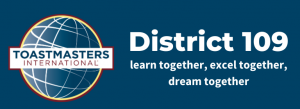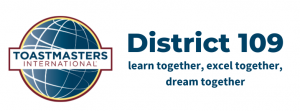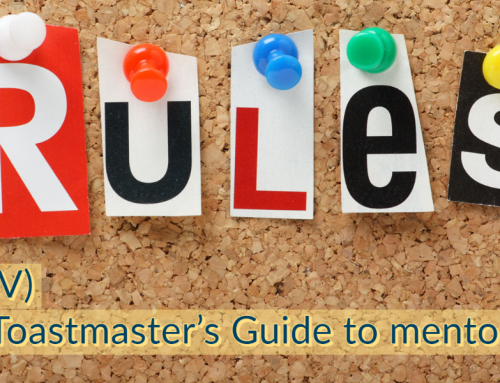Toastmasters: Your Leadership MBA Part 2
by Lukas Liebich, DTM
Quarter One: The Language of a Toastmaster
Your Leadership MBA-PART 2 If there is one thing to start within Toastmasters – it is public speaking. Toastmasters’ tagline is: “Where Leaders Are Made.” Yet, the foundation – or you could call it the “Language of Toastmasters” still lies in public speaking. Every Pathway Project needs to be presented to the public. Every Toastmasters meeting consists of people taking turns speaking publicly. And the most-watched event in Toastmasters is the World Championship of Public Speaking.
Then, Let’s do just that. While for most “standard” Toastmasters, the pace of one speech per month is already good enough; you’ll be giving one speech weekly.
Okay, calm down, calm down. I know this sounds a lot, especially if you compare it to what most of your peers in the club are doing. But If you’ve committed to at least 10 hours per week, that is enough to prepare a 7-minute speech even on the most intricate topics. Here’s a guideline on how you can split your time:
1 hour: Carefully read the Pathways project and fill out any of the supporting documents if needed
30 minutes: Decide the topic (discuss with your mentor or a colleague if you like)
One hour: Read on the topic for 30 minutes.
Two hours: Write the first draft.
2 hours: Improve the draft: 2 hours
One hour: Rehearse the speech at least three times.
Two hours: Deliver the speech at the meeting. Seven minutes to deliver; the rest of the 2 hours are free!
Thirty minutes: Synthesize the feedback & write 1-2 things you want to improve.
I know that 10 hours – and one speech – per week sounds like a lot. But imagine: In 3 months, you will improve more than most of your peers in a year. Just that you’ll make progress so quickly will brand you as a Toastmasters enthusiast and a public speaking prodigy and gain you respect among your Toastmasters colleagues. A good to have for what you’ll want to do in Quarter Two!
Quarter Two: Volunteer
Toastmasters offers many “Entry Level” volunteering opportunities. We’re considering that you want to learn a lot and learn fast, so I will highlight those that I believe are relevant for you.
From Club Leadership roles, you want to aim at one of the “VP” roles: VP Education, VP Membership, or VP Public Relations. The Club President role is a great leadership challenge but should be performed by someone who did at least one of the “VP” roles before – so keep that one for later! The other three Club Officer Roles (Secretary, Treasurer, Sergeant@Arms) are good entry points but are not as demanding as the “VP” roles. In short, It’s not for you right now!
Each VP Role has a clear objective: The VP of Public Relations needs to attract people to the meeting. VP Membership needs to convert guests to members and keep existing members happy in the club (so they stay). VP Education ensures members progress through Pathways by holding every meeting with speakers.
Each of the roles has a set of prescribed “must-have” activities. But you’re here for the learning, so you will want to go “beyond the basics.”
For example:
The VP of Public Relations job is to attract people from the public to attend your club’s Toastmasters meeting. These days, the “Basic” activity consists of creating a social media post for your club’s events. But there’s so much more you can do. Just ask yourself: “How might we attract more people from the public to attend our club’s Toastmasters meeting?”
You can record a promotional video starring some of your club members, organize a storytelling event at a nearby university campus, throw a Toastmasters meeting in front of a shopping mall… Or something completely different. A clear goal and people willing to help you are excellent starting conditions for your experiments. Try stuff out, learn what works and what doesn’t – and improve your skills along the way! Since you want to practice your leadership – you may wish to enroll others in your activity.
It’s the same with the other VP roles; check the Club Leadership Handbook for their objectives!
Note: You may not be as lucky to find an “opening” in your club when needed – but do not despair. You can 1) look in one of the other clubs in your area (you’re offering help; who wouldn’t welcome that?) and 2) support your Area or Division Director. They take care of PR, Membership Growth, and Education – and the supporting roles are often not filled, so you have a big chance of getting a free one there. And in case there’s nothing free – offer your help to an officer currently in position. Who would reject a volunteer willing to help?
Quarter Three: Do a Project
The roles supporting club operations (such as the VPs) benefit from regular and continuous work. But it’s the projects that often pack the most learning in a short amount of time. For example, when you need to organize a Division Conference with contests, the deadline is clear (you’ll set a date when the event needs to take place, won’t you?) and quite a clear idea of what the result should look like (a good Division event hosting a hundred members, smoothly run contests, everybody getting enough food and coffee – or survived all the Zoom time without going crazy – in the process).
I recommend you try the High-Performance Leadership project for the maximum learning effect. The project will guide your steps from the preparation phase, where you will define the vision, recruit the team, and plan actions through delivery and reflection after the event divides the apparent project management (likely also some crisis management) experience, organizing an event is a great way to meet and get to know people. Your team members, event speakers, and local Toastmasters District Officers – all of they will enrich your network.
Bonus comment: It’s much more fun than getting a Project Management Certificate.
Quarter Four: Pack it in a Training
To shine as a leader, you must share what you know! Delivering training based on what you’ve learned during your experience is a great way to cement your learning and a great thing to do for your community. I’m giving you the whole quarter for this one. Preparing 45-60 minute training for the first time can be daunting -, but it’s doable if you’ve planned for it ahead of time!
In Toastmasters, there is always a great hunger for trainers. The Club Office Trainings (COTs) or Toastmasters Leadership Institutes (TLIs) are organized in two seasons (between June and August and between November and February). If you want to deliver your training outside that window, no problem. You can organize a separate club event for it as well.
As a first step, get yourself a “sponsor” who will tell you what training they need. If it’s for a COT or TLI, talk to your Area or Division Director.
They usually have a list of topics they need to be covered (you can do your pre-read at ( https://www.toastmasters.org/leadership-central/district-leader-tools/training/club-officer-training-materials), but if there’s a relevant topic you’re passionate about sharing, you might as well propose to them a topic of your own. Especially if you’ve made a name for yourself as a speaker and a leader in the previous quarters, chances are they’ll be happy to have you speak anyway (this is where your earlier hard work pays off).
…and when you’re done, Take a Look Back!
At the end of the year, you might feel that this was all a bit exhausting. You’ll be right! You did in a year what very few Toastmasters manage ever – and those who do take four or five years.
Your public speaking skills have gone through the roof. You have gained respect for yourself in the community. You have expanded your network. And now, you have a full-blown training ready. Yes, you have already delivered it – but guess what? You can use it repeatedly with different audiences – the same way a Rock band plays the same set when they go on a world tour.
And if you’re hungry for fame and glory – maybe you can write a book! Who knows, perhaps you are the next Tim Ferriss!
![]()








